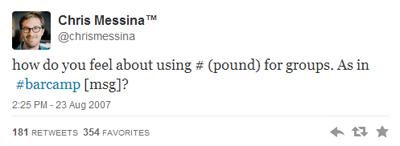Hashtags 101: #whatyouneedtoknow

History of the Hashtag
When Chris Messina suggested using the pound sign as a way to guide Twitter conversations of attendees at a conference he was organizing, it was simply out of convenience. As Messina tells it, the symbol made it easy for anyone to signal keywords and create an ongoing dialogue, and it required the fewest keystrokes on his Nokia phone.
Originally, Messina’s idea was not embraced by Twitter users after he first suggested the use of hashtags in 2007. He was mocked and told that the pound sign had no practical use. Twitter would evolve and users would be able to aggregate their own conversations, they said.
Then, several months later, in October, 2007, devastating fires were sweeping through San Diego. While the public was searching everywhere for evacuation updates and more details, Messina suggested to one of the citizen journalists updating residents via Twitter that they use #sandiegofire to guide the conversation. From that point on, Twitter and the hashtag were forever linked.
Other applications began to follow suit by using hashtags, but it wasn’t until 2009 that Twitter formally adopted Messina’s brainchild by adding hyperlinks to all hashtags, integrating them into search options and introducing “trending topics,” which places popular hashtags on users’ homepages.
Understanding the Hashtag
Knowing how the hashtag came into existence helps to explain its usage, but it doesn’t really explain the whole phenomenon. While using the symbol # as a metadata tag is one thing, the branding of the hashtag as a cultural icon is something else entirely.
Jimmy Fallon and Justine Timberlake epitomized the over usage of the term “hashtag” in a skit on Fallon’s late night show this past September. But as ridiculous as the characters they portrayed (who use hashtag as a precursor to every sentence) made the symbol seem, usage of the word outside of the Twittersphere has not slowed. And now that Facebook, Pinterest, Tumblr and Instagram, among other platforms, have begun to incorporate the hashtag into their applications, the symbol and the word are destined to be a part of the mainstream vocabulary for years to come. And for many of us who grew up using the pound sign to indicate unit of measurement, we will have to get used to a more modern interpretation and usage of the symbol.
Since the hashtag is here to stay, it is important for anyone looking to become more engaged on social media to understand how to use it. The symbol turns any word or word grouping that follows it into a searchable link, allowing you to organize content and track discussion topics based just on those keywords. Let’s say you wanted to post something about holiday events in Central Pennsylvania, you could try something like #harrisburgholidays to see all the posts that mention those keywords.
For your business, you may want to use a hashtag that includes your name such as #AdAbility or something less specific like #smallbiz. Using these types of categories improves the chances that other people on Twitter will find your tweets in their targeted searches. You can also ask your followers to include a unique hashtag in their own tweets as part of your marketing campaign that will make all of those tweets easy to search and organize during your campaign.
Hashtags have been extremely effective for many companies, but there are the exceptions. In November, JPMorgan Chase & Co., the country’s largest bank and the target of several Justice Department investigations, was mocked on Twitter when they asked followers to send questions to a bank executive at #AskJPM. The original post lasted less than six hours before the bank pulled it after receiving more than 6,000 responses, many of which were sarcastic indictments of the bank’s legal woes. Posts like “Can I have my house back?” and “Is it true JPM stands for ‘Just Pay More’? focused more on the bank’s negatives than on the positive input they had hoped to receive.
Bottom line is that Twitter, like all social media, is an evolving communication tool that requires understanding and monitoring. Get familiar with Twitter, use a few hashtags and see how it works for you.
